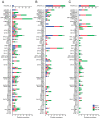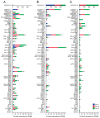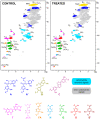A Multiomic Approach to Understand How Pleurotus eryngii Transforms Non-Woody Lignocellulosic Material
- PMID: 34071235
- PMCID: PMC8227661
- DOI: 10.3390/jof7060426
A Multiomic Approach to Understand How Pleurotus eryngii Transforms Non-Woody Lignocellulosic Material
Abstract
Pleurotus eryngii is a grassland-inhabiting fungus of biotechnological interest due to its ability to colonize non-woody lignocellulosic material. Genomic, transcriptomic, exoproteomic, and metabolomic analyses were combined to explain the enzymatic aspects underlaying wheat-straw transformation. Up-regulated and constitutive glycoside-hydrolases, polysaccharide-lyases, and carbohydrate-esterases active on polysaccharides, laccases active on lignin, and a surprisingly high amount of constitutive/inducible aryl-alcohol oxidases (AAOs) constituted the suite of extracellular enzymes at early fungal growth. Higher enzyme diversity and abundance characterized the longer-term growth, with an array of oxidoreductases involved in depolymerization of both cellulose and lignin, which were often up-regulated since initial growth. These oxidative enzymes included lytic polysaccharide monooxygenases (LPMOs) acting on crystalline polysaccharides, cellobiose dehydrogenase involved in LPMO activation, and ligninolytic peroxidases (mainly manganese-oxidizing peroxidases), together with highly abundant H2O2-producing AAOs. Interestingly, some of the most relevant enzymes acting on polysaccharides were appended to a cellulose-binding module. This is potentially related to the non-woody habitat of P. eryngii (in contrast to the wood habitat of many basidiomycetes). Additionally, insights into the intracellular catabolism of aromatic compounds, which is a neglected area of study in lignin degradation by basidiomycetes, were also provided. The multiomic approach reveals that although non-woody decay does not result in dramatic modifications, as revealed by detailed 2D-NMR and other analyses, it implies activation of the complete set of hydrolytic and oxidative enzymes characterizing lignocellulose-decaying basidiomycetes.
Keywords: Pleurotus eryngii; carbohydrate-active enzymes; lignin-modifying enzymes; lignocellulose transformation; metabolomics; oxidoreductases; proteomics; solid-state fermentation; transcriptomics; wheat–straw.
Conflict of interest statement
The authors declare no conflict of interest.
Figures














Similar articles
-
Expanding the Physiological Role of Aryl-Alcohol Flavooxidases as Quinone Reductases.Appl Environ Microbiol. 2023 May 31;89(5):e0184422. doi: 10.1128/aem.01844-22. Epub 2023 May 8. Appl Environ Microbiol. 2023. PMID: 37154753 Free PMC article.
-
Label-free comparative proteomic analysis of Pleurotus eryngii grown on sawdust, bagasse, and peanut shell substrates.J Proteomics. 2024 Mar 15;294:105074. doi: 10.1016/j.jprot.2024.105074. Epub 2024 Jan 8. J Proteomics. 2024. PMID: 38199305
-
Secretome analysis of Pleurotus eryngii reveals enzymatic composition for ramie stalk degradation.Electrophoresis. 2016 Jan;37(2):310-20. doi: 10.1002/elps.201500312. Epub 2015 Nov 27. Electrophoresis. 2016. PMID: 26525014
-
Oxidative Machinery of basidiomycetes as potential enhancers in lignocellulosic biorefineries: A lytic polysaccharide monooxygenases approach.Bioresour Technol. 2023 Oct;386:129481. doi: 10.1016/j.biortech.2023.129481. Epub 2023 Jul 10. Bioresour Technol. 2023. PMID: 37437815 Review.
-
Oxidoreductases on their way to industrial biotransformations.Biotechnol Adv. 2017 Nov 1;35(6):815-831. doi: 10.1016/j.biotechadv.2017.06.003. Epub 2017 Jun 15. Biotechnol Adv. 2017. PMID: 28624475 Review.
Cited by
-
Fungi as a source of eumelanin: current understanding and prospects.J Ind Microbiol Biotechnol. 2023 Feb 17;50(1):kuad014. doi: 10.1093/jimb/kuad014. J Ind Microbiol Biotechnol. 2023. PMID: 37336591 Free PMC article.
-
Comparative genomics reveals carbohydrate enzymatic fluctuations and herbivorous adaptations in arthropods.Comput Struct Biotechnol J. 2024 Oct 18;23:3744-3758. doi: 10.1016/j.csbj.2024.10.027. eCollection 2024 Dec. Comput Struct Biotechnol J. 2024. PMID: 39525084 Free PMC article.
-
Structure-function characterization of two enzymes from novel subfamilies of manganese peroxidases secreted by the lignocellulose-degrading Agaricales fungi Agrocybe pediades and Cyathus striatus.Biotechnol Biofuels Bioprod. 2024 Jun 1;17(1):74. doi: 10.1186/s13068-024-02517-1. Biotechnol Biofuels Bioprod. 2024. PMID: 38824538 Free PMC article.
-
Hydrolytic Enzymes in the Secretome of the Mushrooms P. eryngii and P. ostreatus: A Comparison Between the Two Species.Molecules. 2025 Jun 7;30(12):2505. doi: 10.3390/molecules30122505. Molecules. 2025. PMID: 40572471 Free PMC article.
-
Induction of Extracellular Hydroxyl Radicals Production in the White-Rot Fungus Pleurotus eryngii for Dyes Degradation: An Advanced Bio-oxidation Process.J Fungi (Basel). 2024 Jan 7;10(1):52. doi: 10.3390/jof10010052. J Fungi (Basel). 2024. PMID: 38248961 Free PMC article.
References
-
- Dahmen N., Lewandowski I., Zibek S., Weidtmann A. Integrated lignocellulosic value chains in a growing bioeconomy: Status quo and perspectives. GCB Bioenergy. 2019;11:107–117. doi: 10.1111/gcbb.12586. - DOI
-
- Kobayashi A., Fukuoka A. Synthesis and utilisation of sugar compounds derived from lignocellulosic biomass. Green Chem. 2013;15:1740–1763. doi: 10.1039/c3gc00060e. - DOI

